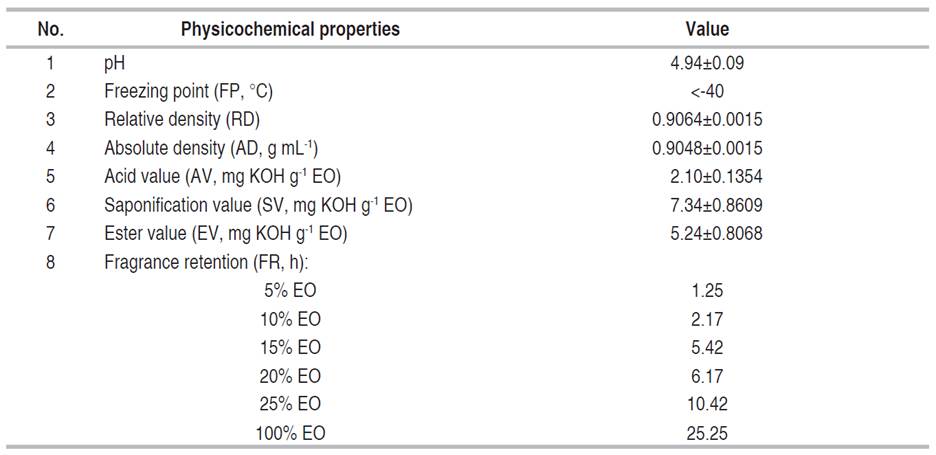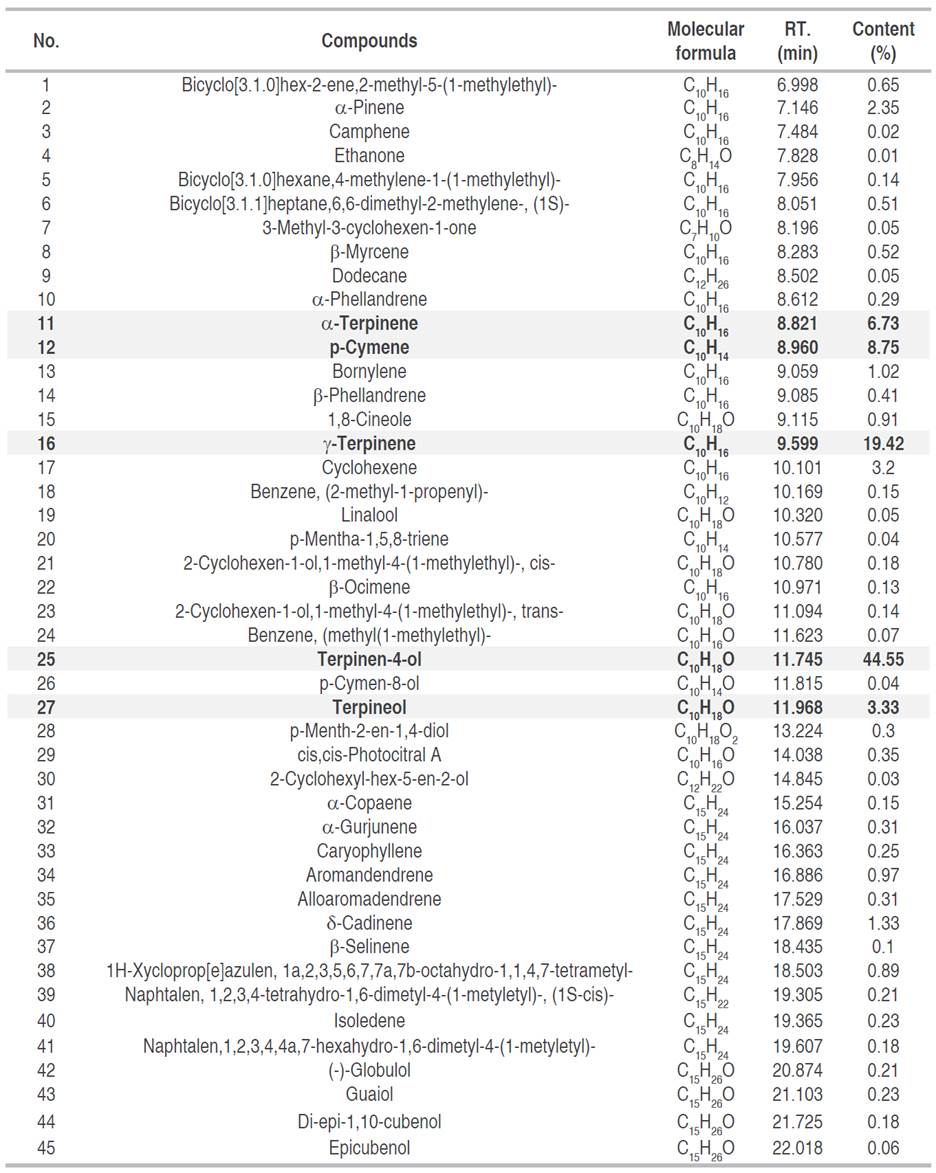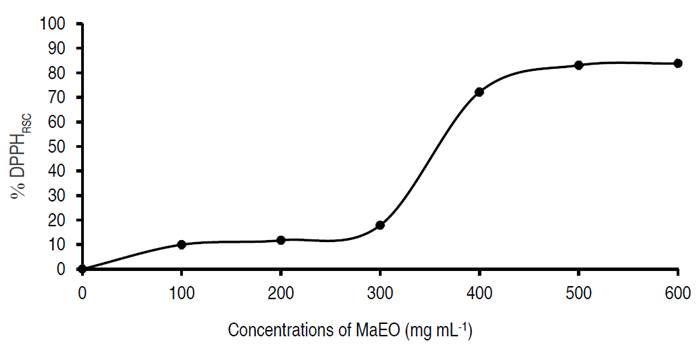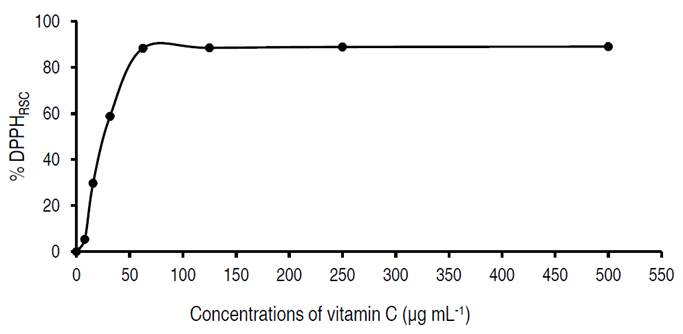Melaleuca alternifolia L., commonly known as thetea tree, belongs to the family Myrtaceae, native to Australia (Rodney et al. 2015). Currently, it is widely distributed globally, mainly in Australia, tropical America, South Asia, and Indonesia (Yasin et al. 2021). Tea tree is a white-barked shrub up to 7 m tall, with narrow leaves scattered into cymbals, 10-35 mm long and 1 mm wide, and the leaves are especially rich in essential oils. Tea tree flowers are white, each flower solitary in a bract, with petals 2-3 mm long. The fruit is a woody, cup-shaped capsule 2-3 mm in diameter and has many seeds (Rodney et al. 2015).
The leaves of this plant can help fight wound infections and are used in traditional medicine (Rodney et al. 2015; Yasin et al. 2021). Melaleuca alternifolia leaves essential oil (MaEO) has many applications in various fields, such as agriculture, pharmaceuticals, cosmetics, veterinary products, and food. Currently, tea tree growth is quite popular in Vietnam. Essential oils (EO) comprise terpene hydrocarbons, mainly monoterpenes, sesquiterpenes, and their related alcohols (Carson et al. 2006). According to ISO 4730 (2017), Terpinen-4-ol is the main ingredient in tea tree oil, with concentrations ranging from 35 to 48%. The ingredients' content significantly differs depending on geographical location, extraction method, harvesting season, and storage conditions (Borotová et al. 2022). MaEO has high biological activity, including antibacterial, antifungal, and antiviral activities, which has been studied on many bacteria and fungi (Carson et al. 2006). The application of MaEO in food preservation has been studied quite a lot in recent years. Typically, chitosan films obtained in malic acid with MaEO have the highest antioxidant activity, color, and insignificant transparency change (Cázon et al. 2021). In addition, MaEO is used to inhibit molds isolated from meat products (Sevik et al. 2021).
It knows that the same plant material distributed in different regions will have different characteristics. Until now, many studies have been related to the tea tree and its essential oil. However, this is the first time M. alternifolia has been grown in Lam Dong province (Vietnam) and the MaEO may differ from that in other regions regarding volatile chemical composition and biological activities. Therefore, this study aimed to evaluate the physicochemical properties, chemical profile, and biological activities of MaEO. The results of this study could contribute significantly to understanding this essential oil in various regions. With its distinctive chemical composition and biological properties, this material holds potential applications in food technology, medicine, and cosmetics.
MATERIALS AND METHODS
Materials
The leaves of M. alternifolia were harvested after about 9 months of age in Lam Dong province, Vietnam (Coordinates: 11°40'1.20"N, 107°19'58.80"E). The plant specimen (coded MA151022VST) has been archived at the Plant Biotechnology Laboratory of the Institute of Biotechnology and Food Technology, Ho Chi Minh City University of Industry. On average, the per-batch yield was approximately 50 kg leaves/batch and MaEO was extracted using steam distillation for 3 h at 100 °C, with the yield obtained at about 1.5% (v/w), and the EO was stored in a dark sealed bottle at 4 °C before analysis.
Bacterial strains used in this study include Staphylococcus aureus (ATCC 25923), Bacillus cereus (ATCC 11778), Escherichia coli (ATCC 25922), and Salmonella enterica (ATCC 10376).
Determination of physicochemical properties of MaEO
The freezing point (FP), relative density (RD), absolute density (AD), acid value (AV), esters value (EV), and saponification value (SV) were evaluated according to International Organization for Standardization including ISO 1041 (1973), 279 (1998), 1242 (2023), and 7660 (1983), respectively.
Determination of fragrance retention (FR) of MaEO
According to the procedure described by Mahajan (2022), fragrance retention (FR) is determined by the concentration of the flavoring ingredient and its retention time, with some minor corrections. EO was mixed into concentrations (5, 10, 15, 20, and 25%, v/v) in 96% ethanol. Next, three drops of EO were placed on the odor test paper, and a few seconds were allotted for the EO to penetrate the paper. Finally, the time until the smell of EOs disappeared was calculated and the results recorded.
Gas chromatography-mass spectrometry (GC-MS)
The chemical volatile composition of EO was analyzed using the GC-MS method. 1 μL of EO was injected into a gas chromatograph (Shimadzu Nexis GC-2030, Japan) with a versatile capillary column (Rtx-5sil-MS, 30 m×0.25 mm×0.25 μm, Restek Technologies, USA) equipped with a quadrupole mass analyzer (Shimadzu GC-MS-QP2020 NX, Japan). Helium was used as a carrier gas at a constant flow rate of 3 mL min-1, and a split ratio of 10:1. The injection temperature was 250 °C and the temperature program was set as follows: initial temperature of 50 °C, held for 2 min, increased until 250 °C at a rate of 10 °C min-1, and held for 5 min; finally, increased to 280 °C at a rate of 10 °C min-1, and held for 3 min. Mass spectra were recorded at the ionization energy of 70 eV in EI mode (Hao and Quoc 2024).
Determination of antioxidant capacity (AC) of MaEO
The AC of MaEO was determined using DPPH assay according to the procedure described by Rahman et al. (2015) with some minor corrections. EOs were diluted into concentrations (100, 200, 300, 400, 500, and 600 mg mL-1) in 96% ethanol. 0.3 mL of the obtained EO and 3.7 mL DPPH 0.1 M in 96% ethanol solution were mixed. The mixture was kept in dark conditions for 30 min at room temperature. DPPH radical scavenging capacity (DPPHRSC) of MaEO was expressed by the degree of color reduction of the DPPH solution, as determined by measuring the absorbance at a wavelength of 517 nm, and antioxidant capacity was calculated following equation 1, while vitamin C was used as a control. Percent inhibition plotted against EO concentration to estimate concentration gives 50% inhibition (IC50).
Determination of the antibacterial activity (AA) of MaEO
The AA was determined by susceptibility testing by the agar plate diffusion method described by Quyen and Quoc (2023) with minor adjustments. First, a sterile spreader spread 100 μL of bacterial suspension (0.5 McFarland standard, approximately 1.5×108 CFU mL-1) onto Muller-Hinton agar medium (MHA). Then, paper plates with a diameter of 6 mm were impregnated with essential oils (5 μL) put on MHA media, while ampicillin (10 μg disc-1) and 5% dimethyl sulfoxide (DMSO) solution (5 μL disc-1) were used as a positive and negative control. Petri dishes were incubated for 24 h at 37 °C, and the diameter of the inhibition zone was measured in mm.
Statistical data analysis
All the experimental results were analyzed using Statgraphics Centurion software (Version 15.1.02). Every assay was done in triplicates. Analysis of variance (ANOVA) with Fisher's least significant difference procedure was used to determine the significant differences (P<0.05) between means.
RESULTS AND DISCUSSION
Determination of physicochemical properties of Melaleuca alternifolia leaf essential oils
MaEO is a light-yellow liquid with a characteristic odor and a bitter taste. The physicochemical properties of EO are shown in Table 1. The pH value of MaEO is about 4.94 and this result is higher than that in some EOs from other materials, such as Melaleuca cajuputi leaves (pH=4.46) (Quoc 2021) and Ceratonia siliqua pulp (pH=4.3) (Ouis and Hariri 2018). The chemical component of EO affects pH strongly, leading to a significant difference in pH in materials.
The FP of EO remains undetermined at -40 °C; the oil still exists in liquid form, with no freezing phenomenon. The results show that the FP of MaEO must be below -40 °C; compared to other materials, FPs of the EO of M. cajuputi leaves and Ocimum gratissimum were -45 and -38 °C (Quoc 2021; Hao and Quoc 2024). This indicated that FP depends on the chemical composition of the EO significantly. In addition, the RD and AD of the oil were also analyzed; both values are lower than one, 0.9064 and 0.9048 g mL-1, respectively. These findings agree with the ISO 4730 (2017), and they did not differ significantly from those of M. cajuputi (RD: 0.9102 and AD: 0.9086 g mL-1) (Quoc 2021) or M. arvensis (RD: 0.8987 and AD: 0.8959 g mL-1) leaves' EO (Quoc 2022). The obtained values also revealed that the MaEO belongs to the EO group lighter than water.
The AV, SV, and EV of MaEO were determined to be 2.10, 7.34, and 5.24 mg KOH g-1 EO, respectively. In general, the AV is agreement with that of previous studies for other materials, such as C. siliqua pulp and seeds (AV: 3.82 and 2.2 mg g-1 EO) (Ouis and Hariri 2018), basil EO (AV: 3.95 mg KOH g-1 EO), and lemongrass (AV: 4.09 mg KOH g-1 EO) (Mustapha 2018), while the obtained SV is significantly lower than that of M. cajuputi leaves EO (SV: 28.05 mg KOH g-1 EO) (Quoc 2021), basil EO (SV: 198 mg KOH g-1 EO), and lemongrass (SV: 143 mg KOH g-1 EO) (Mustapha 2018). The AV, SV, and EV are indicators used to assess the quality of the EO and they are influenced by distillation technique, cultivar, climatic conditions, harvest period, and chemical composition of the initial materials. The staying power is also the critical index to evaluate the quality of EO. In this study, FR of MaEO can reach a range of 6-10 h at 20-25%, and this shows that FR is quite long, similar to perfume at a fragrance concentration of 20-30%, and it can last for more than 6-8 h (Mahajan 2022), while pure MaEO can last more than 24 h. This finding proves that MaEO has potential applications in cosmetics and the food industry.
Chemical composition of Melaleuca alternifolia leaves essential oils
The volatile compounds of MaEO were analyzed by GC-MS. The results are displayed in Table 2. A total of 45 compounds were identified and quantified in the EO isolated from the M. alternifolia leaves; they account for 99.35% of the oil and are tested by retention times ranging from 7 to 22 min. Compounds comprising the highest content in MaEO, include Terpinen-4-ol (44.55%), γ-Terpinene (19.42%), p-Cymene (8.75%), α-Terpinene (6.73%), and Terpineol (3.33%). These components play an important role in the quality of MaEO and there is variation in the chemical composition of EO from tea tree leaves collected in different regions. In previous studies, authors also used the distillation method to extract EOs from the initial material. For example, MaEO isolated from Tien Giang province (Vietnam) possess 19 volatile components: Terpinen-4-ol (36%), γ-Terpinene (17.8%), 1,8-Cineole (10%), etc. (Hòa et al. 2016), while MaEO from Slovakia has 47 identified components, including Terpinen-4-ol (40.3%), γ-Terpinene (11.7%), 1,8-Cineole (7%), p-Cymene (6.2%), etc. (Borotová et al. 2022), and while MaEO collected in Thailand has 24 components, including Terpinen-4-ol (30.42-34.76%), γ-Terpinene (25.08-26.23%), α-Terpinene (12.31-12.43%) and 1,8-Cineole (5.99-9.08%), etc. (Sukatta et al. 2011). In this study, the main component of MaEO is Terpinen-4-ol and its content is higher than that in MaEO from other places. The MaEO from the Lam Dong province complied with the ISO 4730 (2017) standard analysis with few variations in the contents of major constituents. This difference in the chemical composition of MaEO can be explained due to different extraction methods, climatic conditions, harvesting periods, genes, etc.
Antioxidant capacity (AC) of Melaleuca alternifolia leaves essential oils
Figures 1 and 2 show the efficiency of the antioxidant process of EO and control (vitamin C). An increase in MaEO concentration leads to an increase in AC. Based on the obtained curve, the IC50 of MaEO was determined at 360 mg mL-1 (Figure 1), while the IC50 of vitamin C was only about 26 µg mL-1 (Figure 2). The results show that the IC50 of MaEO is much higher than that of vitamin C, showing that the AC of EO is very weak. These results are consistent with those of MaEO from Thailand (IC50: 29.34-38.68 mg mL-1) (Sukatta et al. 2011) (Their AC is extremely low compared to the control). Besides, compared to some EOs from other materials, such as C. siliqua pulp and seeds (IC50: 7.8 and 31.25 µg mL-1) (Ouis and Hariri 2018), M. arvensis (IC50: 330 mg mL-1) (Quoc 2022), the AC of MaEO is also weaker. This is a disadvantage when applying this EO in the cosmetic and food industry. Differences in AC of various EOs may be due to differences in their chemical composition.
Antibacterial activity (AA) of Melaleuca alternifornia leaves essential oils
Table 3 shows that MaEO exhibited to AA against four bacterial strains, and ampicillin was used as an inhibitory control against the bacteria used in the study. AA of ampicillin are arranged in order of susceptibility: E. coli > S. enterica>S.aureus/B. cereus. Similarly, AA of MaEO is arranged in order of susceptibility: E. coli >S. enterica/S. aureus/B. cereus. The AA of MaEO was 1.5 times stronger than that of ampicillin for S. aureus and B. cereus, while the AA of MaEO was much lower than that of ampicillin for S. enterica and E. coli. These obtained results are also different from those of MaEO collected from Thailand (Sukatta et al. 2011) and other materials (C. siliqua pulp and seeds, M. cajuputi leaves, and O. gratissimum EO) (Ouis and Hariri 2018; Quoc 2021; Hao and Quoc 2024). The AA of MaEO was observed in the presence of a high content of Terpinen-4-ol; according to Halcón and Milkus (2004), Terpinen-4-ol strongly influences the bacterial cell wall and compromises the cytoplasmic membrane of bacteria (S. aureus), giving it a bacteriostatic and bactericidal effect. In addition, combining other bioactive ingredients, such as γ-Terpinene, 1,8-Cineole, α-Terpineol, etc., can also increase the ability to inhibit bacteria.
CONCLUSION
The essential oil distilled from M. alternifornia leaves in Lam Dong province, Vietnam, exhibits unique physicochemical properties, notably exceptional fragrance retention lasting approximately 25 h for pure EO. It has weak AC compared to the control. However, this material also possesses high AA and strongly inhibits four pathogenic bacterial strains in food, including E. coli, S. enterica, S. aureus, and B. cereus. By the GC-MS method, 45 major volatile components were determined in tea tree leaf EO. This is a natural, precious, and rich source of phytochemicals, especially Terpinen-4-ol (44.55%), γ-Terpinene (19.42%), etc. Therefore, the oil from M. alternifornia leaves is ideal for use in the pharmaceutical, food, and cosmetic industries.





















